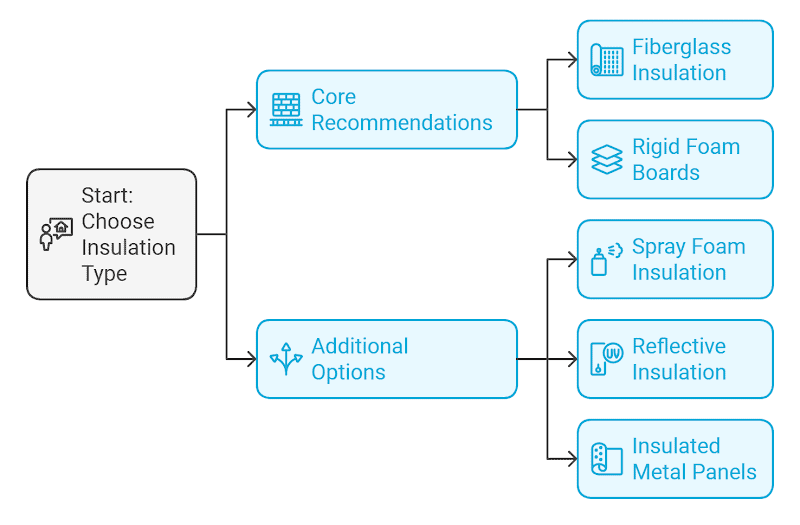Key Takeaways
- Insulation is critical for steel buildings – It keeps your building comfortable year-round by stabilizing indoor temperatures, cutting energy costs, and preventing condensation-related issues like rust and mold.
- Choose the right insulation for your needs – Whether it’s fiberglass for affordability, rigid foam for high performance, or reflective materials for sunny climates, the best solution depends on your building’s purpose and location.
- Placement is key – Focus on insulating the roof and walls to maximize energy savings. Don’t forget to seal gaps and openings for an airtight structure.
- Match insulation to your needs – The right choice depends on your building’s purpose, local climate, and budget. For instance, reflective insulation works best in hot climates, while rigid foam boards are ideal for cold or humid regions.
Table of Contents
Best Types of Insulation for Steel Buildings
To help you quickly understand and choose the right insulation, we’ve grouped the materials into core recommendations and additional options.

Core Recommended Insulation
1. Fiberglass Insulation
Fiberglass is one of the most popular and affordable insulation materials for steel buildings. It works well for roofs and walls, providing reliable thermal control and moisture resistance when paired with a vapor barrier.
Advantages:
- Affordable and easy to install
- Works well for roofs and walls in various building types
Disadvantages:
- Requires protective gear during installation (those fibers can itch!)
- Needs a vapor barrier to prevent moisture problems
2. Rigid Foam Boards
These boards are dense, durable, and offer excellent insulation, making them perfect for walls and roofs where high R-values or moisture resistance are needed.
Advantages:
- Provides consistent coverage, reducing heat leaks (thermal bridging)
- Excellent for cold climates and moisture-prone areas
Disadvantages:
- Costs more upfront compared to fiberglass
- Requires careful sealing at joints for best results
Additional Options
1. Spray Foam Insulation
Spray foam is a high-performance choice for sealing gaps and insulating areas with irregular shapes. It’s especially effective for humid climates or buildings needing airtightness.
Advantages:
- High R-value (up to R-6 per inch)
- Ideal for sealing gaps and moisture-prone areas
Disadvantages:
- Costs more than other materials
- May affect warranties, so check with your building provider
2. Reflective Insulation
This shiny insulation bounces heat away, making it a great choice for hot climates or buildings exposed to strong sunlight.
Advantages:
- Lightweight and simple to install
- Perfect for reducing radiant heat in roofs or walls
Disadvantages:
- Limited insulation in cold weather
- Lower R-value compared to other options
3. Insulated Metal Panels
These sleek panels combine insulation with modern aesthetics, offering excellent performance for walls and roofs in high-end commercial or residential buildings.
Advantages:
- Combines high efficiency with a polished finish
- Reduces the need for additional insulation layers
Disadvantages:
- Higher upfront cost
- Needs professional installation
How Does Insulation Work in a Steel Building?
Think of insulation as a shield. It slows down heat transfer, keeps moisture out, and softens noise. In summer, it keeps the hot air outside, and in winter, it traps warmth inside. It also prevents condensation, which can damage your building with rust or mold. Plus, materials like reflective insulation can bounce light around, improving energy efficiency for lighting. Overall, insulation creates a comfy, durable, and energy-saving environment for your steel building.
For projects requiring enhanced noise control, sound insulation steel buildings combine these benefits with advanced acoustic solutions, ensuring a quieter and more comfortable space.
Where Should Insulation Be Installed in a Steel Building?
To get the most out of your insulation, here’s where to install it:
- Roof: This is where most heat enters or escapes, so it’s the first place to insulate. Use materials like fiberglass, rigid foam boards, or reflective insulation.
- Walls: Insulating the walls improves comfort, reduces energy bills, and adds soundproofing. Great materials here include rigid foam boards and insulated metal panels.
- Floors (Optional): In extreme climates or for sensitive storage, insulated floors can block ground moisture and improve thermal performance.
- Gaps and Openings: Seal around windows, doors, and vents with spray foam to stop air leaks.
Factors to Consider When Choosing Insulation
Building Purpose:
- Industrial: Focus on reducing noise and managing moisture.
- Commercial: Aim for comfort and energy efficiency.
- Residential: Balance temperature control, noise reduction, and cost.
Location and Climate:
- Hot Areas: Reflective insulation works well for radiant heat.
- Cold Areas: Go for rigid foam boards or high R-value materials.
- Humid Areas: Moisture-resistant materials like vapor barriers and spray foam are key.
Budget:
- Low Budget: Fiberglass and reflective insulation offer great value.
- High Budget: Rigid foam boards and insulated metal panels provide the best long-term savings.
Thickness:
- Aim for 3–6 inches of insulation to achieve good energy efficiency and moisture protection.
Why Do Steel Buildings Need Insulation?
Steel buildings are highly responsive to external temperatures because steel conducts heat quickly. This means they can get uncomfortably hot in the summer and lose heat rapidly in the winter. Insulation is a must-have solution to make these buildings more comfortable and efficient. Here’s why:
Keeps Temperatures Comfortable
Insulation helps maintain a steady indoor temperature by slowing down heat transfer. This reduces the effort needed from heating and cooling systems, lowering your energy bills and keeping the space cozy.
Stops Moisture Problems
Insulation acts as a barrier against moisture, preventing condensation that can cause rust, mold, and even structural damage.
Reduces Noise
Insulation doesn’t just block heat—it also blocks sound. It makes your building quieter by keeping outdoor noise out and softening echoes inside.
Extends the Lifespan of Your Building
By reducing temperature swings, insulation protects steel from expanding and contracting too much, which helps prevent structural fatigue and keeps your building strong for longer.

